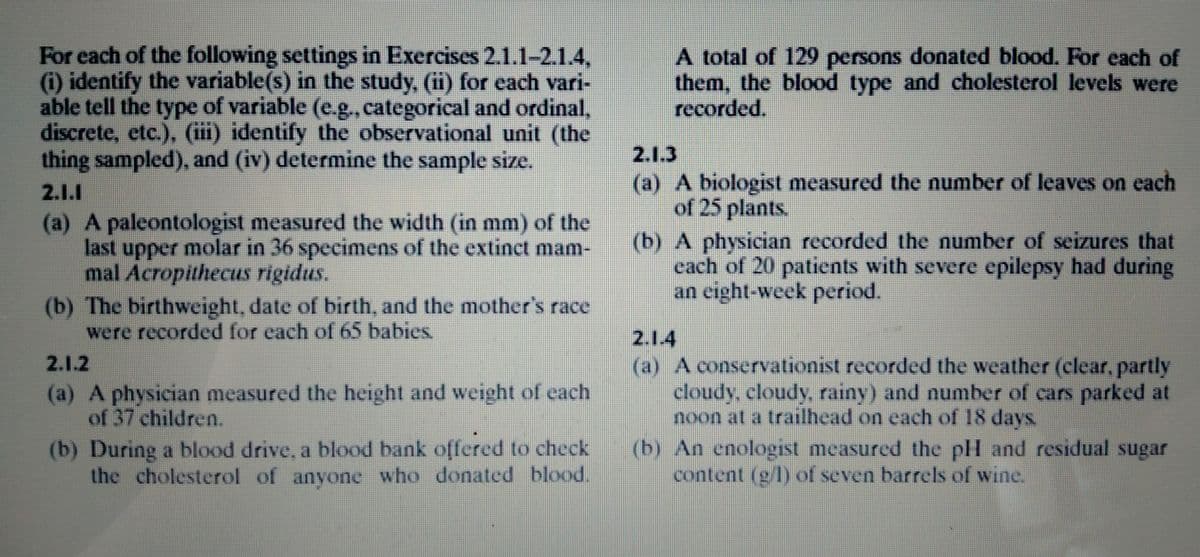For each of the following settings in Exercises 2.1.1-2.1.4, (i) identify the variable(s) in the study, (ii) for each vari- able tell the type of variable (e.g.,categorical and ordinal, discrete, etc.), (iii) identify the observational unit (the thing sampled), and (iv) determine the sample size. A total of 129 persons donated blood. For each of them, the blood type and cholesterol levels were recorded. 2.1.3 (a) A biologist measured the number of leaves on each of 25 plants. 2.1.1 (a) A paleontologist measured the width (in mm) of the last upper molar in 36 specimens of the extinct mam- mal Acropithecus rigidus. (b) The birthweight, date of birth, and the mother's race were recorded for each of 65 babies. (b) A physician recorded the number of seizures that each of 20 patients with severe epilepsy had during an eight-week period. 2.1.4 (a) A conservationist recorded the weather (clear, partly cloudy, cloudy, rainy) and number of cars parked at noon at a trailhead on each of 18 days (b) An enologist measured the pH and residual sugar content (g/l) of seven barrels of wine. 2.1.2 (a) A physician measured the height and weight of each of 37 children. (b) During a blood drive, a blood bank offered to check the cholesterol of anyone who donated blood.
For each of the following settings in Exercises 2.1.1-2.1.4, (i) identify the variable(s) in the study, (ii) for each vari- able tell the type of variable (e.g.,categorical and ordinal, discrete, etc.), (iii) identify the observational unit (the thing sampled), and (iv) determine the sample size. A total of 129 persons donated blood. For each of them, the blood type and cholesterol levels were recorded. 2.1.3 (a) A biologist measured the number of leaves on each of 25 plants. 2.1.1 (a) A paleontologist measured the width (in mm) of the last upper molar in 36 specimens of the extinct mam- mal Acropithecus rigidus. (b) The birthweight, date of birth, and the mother's race were recorded for each of 65 babies. (b) A physician recorded the number of seizures that each of 20 patients with severe epilepsy had during an eight-week period. 2.1.4 (a) A conservationist recorded the weather (clear, partly cloudy, cloudy, rainy) and number of cars parked at noon at a trailhead on each of 18 days (b) An enologist measured the pH and residual sugar content (g/l) of seven barrels of wine. 2.1.2 (a) A physician measured the height and weight of each of 37 children. (b) During a blood drive, a blood bank offered to check the cholesterol of anyone who donated blood.
Glencoe Algebra 1, Student Edition, 9780079039897, 0079039898, 2018
18th Edition
ISBN:9780079039897
Author:Carter
Publisher:Carter
Chapter10: Statistics
Section10.4: Distributions Of Data
Problem 19PFA
Related questions
Question
answer 2.1.2 to 2.1.4

Transcribed Image Text:For each of the following settings in Exercises 2.1.1-2.1.4,
(i) identify the variable(s) in the study, (ii) for each vari-
able tell the type of variable (e.g., categorical and ordinal,
discrete, etc.), (iii) identify the observational unit (the
thing sampled), and (iv) determine the sample size.
A total of 129 persons donated blood. For each of
them, the blood type and cholesterol levels were
recorded.
2.1.3
(a) A biologist measured the number of leaves on each
of 25 plants.
2.1.1
(a) A paleontologist measured the width (in mm) of the
last upper molar in 36 specimens of the extinct mam-
mal Acropithecus rigidus.
(b) The birthweight, date of birth, and the mother's race
were recorded for each of 65 babies
(b) A physician recorded the number of seizures that
cach of 20 patients with severe epilepsy had during
an eight-week period.
2.1.4
(a) A conservationist recorded the weather (clear, partly
cloudy, cloudy, rainy) and number of cars parked at
noon at a trailhead on each of 18 days.
(b) An enologist measured the pH and residual sugar
content (g/1) of seven barrels of wine.
2.1.2
(a) A physician measured the height and weight of each
of 37 children.
(b) During a blood drive, a blood bank offered to check
the cholesterol of anyone who donated blood.
Expert Solution
This question has been solved!
Explore an expertly crafted, step-by-step solution for a thorough understanding of key concepts.
This is a popular solution!
Trending now
This is a popular solution!
Step by step
Solved in 3 steps

Knowledge Booster
Learn more about
Need a deep-dive on the concept behind this application? Look no further. Learn more about this topic, statistics and related others by exploring similar questions and additional content below.Recommended textbooks for you

Glencoe Algebra 1, Student Edition, 9780079039897…
Algebra
ISBN:
9780079039897
Author:
Carter
Publisher:
McGraw Hill

Glencoe Algebra 1, Student Edition, 9780079039897…
Algebra
ISBN:
9780079039897
Author:
Carter
Publisher:
McGraw Hill